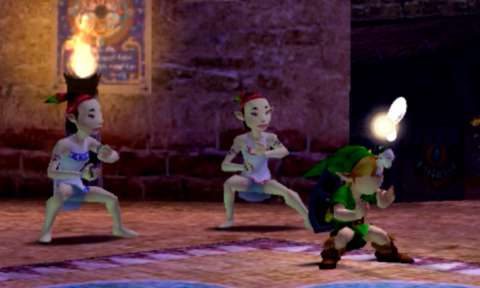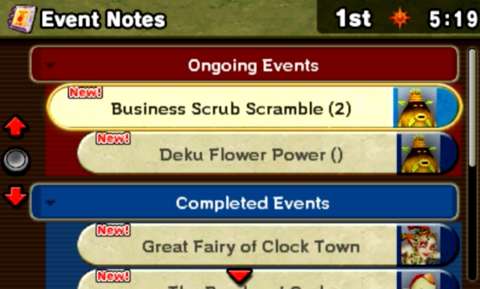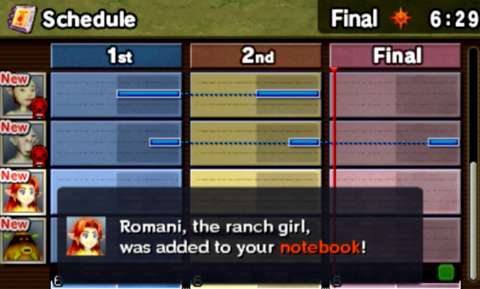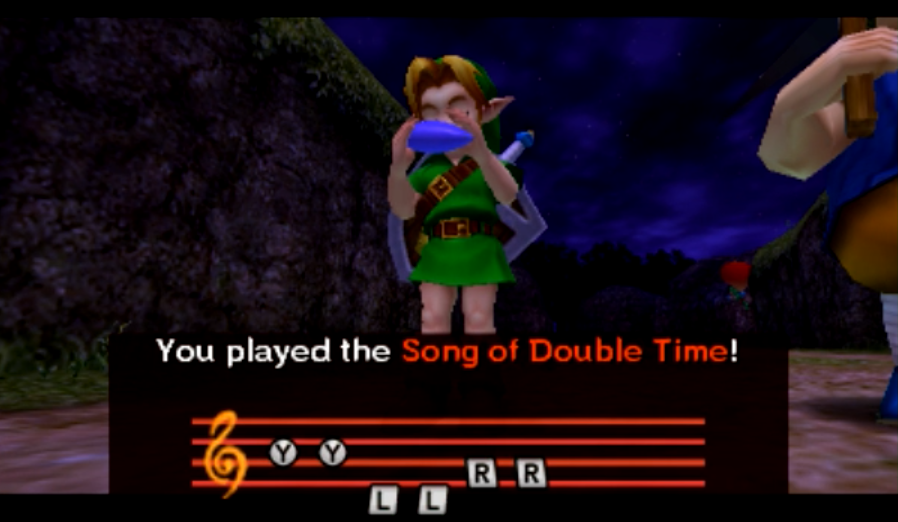It's hard not to compare The Legend of Zelda: Majora's Mask 3D to Nintendo's other foray into handheld Zelda remakes, The Legend of Zelda: Ocarina of Time 3D. Ocarina of Time's upgrades for the 3DS significantly improved the experience; artfully placed Sheikah Stones offered visions and showed where and how to solve the next puzzle, and the 3DS's gyroscope added motion controls to certain actions, such as shooting arrows. These additions were designed to make the game accessible to modern audiences and more palatable for short play sessions.
For 3DS, Majora's Mask was retooled to be friendlier in shorter player sessions, with great success. A more detailed quest log lets you keep track of every completed, uncompleted, and rumored item on your to-do list. You can set alarms to remind you when certain events will occur. Small tweaks to how songs affect time and the flow of boss battles give you deeper control of time itself, while the rearrangement of collectible items throughout dungeons and the overworld make Majora's Mask feel fresh for those coming back after 15 years.
Majora's Mask is inarguably the weirdest Legend of Zelda game. Sometime shortly after the events of Ocarina of Time, our hero Link wanders into a country called Termina. Hyrule it is not: The ominously named region is home to an eerie cast of characters and hosts an inordinate number of strange happenings. An erratic mask salesman hoarding cursed objects? We've got one. Alien abductions? Frequent. Ghost hands in toilets and ghost giants throwing boulders and ghosts doing tai chi on huge mushrooms? More common that you'd like.
The strangest happening is the grimacing moon falling out of the sky. Link is given 72 hours to find Skull Kid, an impetuous young creature, and steal back an item of terrible power, the titular Majora's Mask. To do so, Link must liberate four spirits located in four temples scattered throughout the world. These spirits can help save the world, but for now, they have also fallen prey to the bizarre magic clouding Termina. He only has three days to do it, but with the help of his trusty magic ocarina, Link can rewind time for those three days and live them over and over like some Groundhog Day redux.
Time management is the name of the game here. Anytime during the 72-hour window, you can play the Song of Time to rewind back to dawn of the first day. Having this limit means you must allot yourself ample time to clear regional quests and complete dungeons. In each area, what you do in the surrounding area directly affects your access to the dungeon and side quests, so you'll need those full 72 hours. In one region the town is iced over, and defeating the dungeon boss is the only way to restore spring. In spring you have access to a handful of smaller missions that in turn reveal more major gains, like upping your sword power and finding your long-lost horse. Once, I completed this dungeon and then immediately rewound back to the first day...only to find it all frozen again. It's this kind of thing you need to be mindful of as you play Majora's Mask, and forces you to forgo leisurely exploration in favoring of beelining between quest points.
Like in most Legend of Zelda games, extensive travel across the continent and back is required to collect special items. These items range from a bigger bag to carry your bombs to a bow and arrows and everything in between. The traditional Zelda gear accumulation formula is present: help NPCs to gain helpful combat items, complete dungeons to get useful items like the aforementioned bow and fire arrows, and beat the dungeon boss to collect a key item.
But other than mystical weapons and keys to defeating the game's ultimate enemy--the power of Majora's Mask--you're also on the hunt for masks. Masks do many special things, and, more often than not, donning one can solve a difficult problem. A Blast Mask allows you to explode an enemy or rock wall without using bombs. The Great Fairy mask attracts stray fairies to you, making them easier to collect. Another mask teaches people to dance, another charms animals into parading around after you, and yet another lets you run faster and jump longer. Still more transform you into other Termina races. The Deku Mask turns you into a Deku Scrub and lets you utilize cannon-like flowers and glide through the air, while the Goron Mask grants you powerful punching abilities and the race's stony look. Masks grant you situational powers and are the key to navigating most puzzles. The variety and versatility make it hard to resist taking time to collect them all, especially when you know they'll make life in Termina easier.

When you're not exploring the overworld, running fetch-quests for various townsfolk and mask hunting, you're in dungeons. Majora's Mask features four main dungeons and a handful of mini-dungeons where you can collect rare items like bigger wallets and mystical Zora eggs. Dungeons are the same as they've always been in Zelda: make your way through a labyrinthine, multi-level temple solving environment puzzles to get to the final boss. Defeating this final boss yields a health upgrade and liberates one of the four spirits that can help stop the moon from falling. Puzzles make up the meat of dungeon content, but you still spend an awful lot of time fighting.
Combat in Majora's Mask is simple. You use the left analog stick and face buttons to stab, slash, and parry, while the shoulder buttons help you block with your shield and lock on to enemies. The ability to lock on to enemies is helpful, as some opponents can crawl up onto the ceiling or leap long lengths, and keeping track of them becomes tricky.
Boss battles in Majora's Mask 3D have been substantially fixed, and while they feel more manageable than they did in the Nintendo 64 version, they aren't necessarily easier. These fights have been adjusted to prevent you from exploiting the boss's attack pattern, meaning that they won't always do the same thing with the same regularity in the same way. You need to knock bosses over and then attack their weak spots three times before you're victorious, but this time around, it's harder to sneak in cheap hits when they don't follow the same attack, rinse, and repeat formula. It makes these long fights feel new and interesting and makes success more satisfying. For example, the first dungeon boss can summon waves of smaller critters. The first time this happened, it was a handful of beetles. I expected him to go back to attacking me without his minions, but half a minute later, I had beetles and moths to contend with. Then he went back to attacking me solo until the end of the fight.
While bosses haven't been made easier, some other areas have been. There are more save points throughout the world, mercifully saving you from long stretches of lost progress in the event you fail. The Song of Soaring allows you to teleport to any save point, and now there are more of them to make navigation easier. Additionally, the Song of Double Time lets you fast forward to whatever hour you choose within a same-day window. In the original game, this song only let you fast-forward to dawn or dusk; in the 3DS version, you can teleport to any hour on the hour, allowing you to more carefully manage how and when you complete tasks. This also comes in handy when you just want to quickly wrap up a few side quests before rewinding to the first day and tackling a dungeon.

Even smaller changes make Majora's Mask 3D more digestible in small quantities and make the puzzles feel newer for repeat players. Scattered throughout each dungeon are a dozen or so stray fairies that can be returned to the region's Great Fairy for combat upgrades. These stray fairy locations have been changed up from the original game, so if you think you know where all fairies are going in, you'll likely be hunting a little harder. Some exits put you into areas closer to where you need to go, eliminating running time. For example, after collecting beans underground, I was dumped outside a platform I needed rather than the front of the temple, eliminating a minute of wandering.

But by far the best changes to Majora's Mask are the more detailed and comprehensive Bomber's Notebooks. These notebooks serve as your quest log, helping you keep track of where you should go and what you should be on the lookout for. The original Majora's Mask Notebooks were a little more cryptic and made you sweat out finding solutions a little more. Now, for the 3DS version, literally everything you need to know is there with a button press. The Notebooks keep track of rumors you hear from NPCs and gently suggest where you need to be to complete a task. Successful and failed tasks are also recorded, so if you mess something up on day three, you can rewind to day one and keep better track of how to fix it. These tiny tweaks make the game friendly in small doses. By giving players quick, efficient ways to tackle one sidequest or a mini-dungeon, they've ensured that they'll be comfortable playing the game in short bursts. Lunch breaks and morning commutes can now safely yield a fully completed Majora's Mask task.
The new Notebooks also keep track of the specific day and time that certain events occur and let you set alarms for them, so wherever you are in Termina, you'll know when you need to be back in Clocktown to catch a ghost or some extra cash. This is an amazing addition that makes housekeeping more manageable and lets you keep track of what items you get and when without having to take written notes yourself. Games with Majora's kind of time-management mechanics would do well to steal this gem of an idea.
In Majora's Mask, you have a set number of spaces to equip items and masks, and you're always swapping them around. Having the 3DS bottom screen show your gear and items at all times is an indispensable addition. You can fluidly explode a wall, attract a stray fairy, and then turn into a Deku Scrub and jump into a flower in a hot moment. It's convenient in every way that the original version was tedious. So many different items are needed at any given time, and having them all a tap away saves frustration and, more importantly, in-game time.

Majora's Mask 3D runs just fine on older 3DS models, but the experience is much more improved and cozy on the latest version, the New Nintendo 3DS. The additional tiny C-stick on the right side allows you to change the camera angle at will. This helps the most in boss fights, where both you and the boss are in constant motion, and it's often hard to keep track of where you both are. It also makes navigating large spaces while riding Epona much easier. In one quest, I had to ride around a wide expanse of farmland shooting aliens, and being able to shift where I was looking while riding at breakneck speed made fending them off a breeze.
If you're playing on the old 3DS, you have to lock Link in place and look around with the circle pad or use the gyroscope feature, which can get clunky. It's also frustrating for tasks that require you to move and look around quickly. Boss fights become equally annoying because lock-on targeting becomes the only way to keep tabs on the opposing monster. So while you can use your older 3DS with Majora's Mask 3D, I would highly recommend giving it a go on the newest handheld model.
The overall package for Majora's Mask 3D preserves all the weird delight of the original game while lowering the barrier of entry for new players. There's still a lot that's challenging about the puzzles and fights, but a few minor tweaks make your hard-won heart containers and masks feel that much more satisfying. The changes to how you can control and manage time mean the otherwise dense Majora's Mask is comfortable for shorter play sessions, making it a great fit for the handheld. It's evident that Nintendo put a lot of thought into updating this classic, which takes the game beyond a simple remake to become a new-old classic.